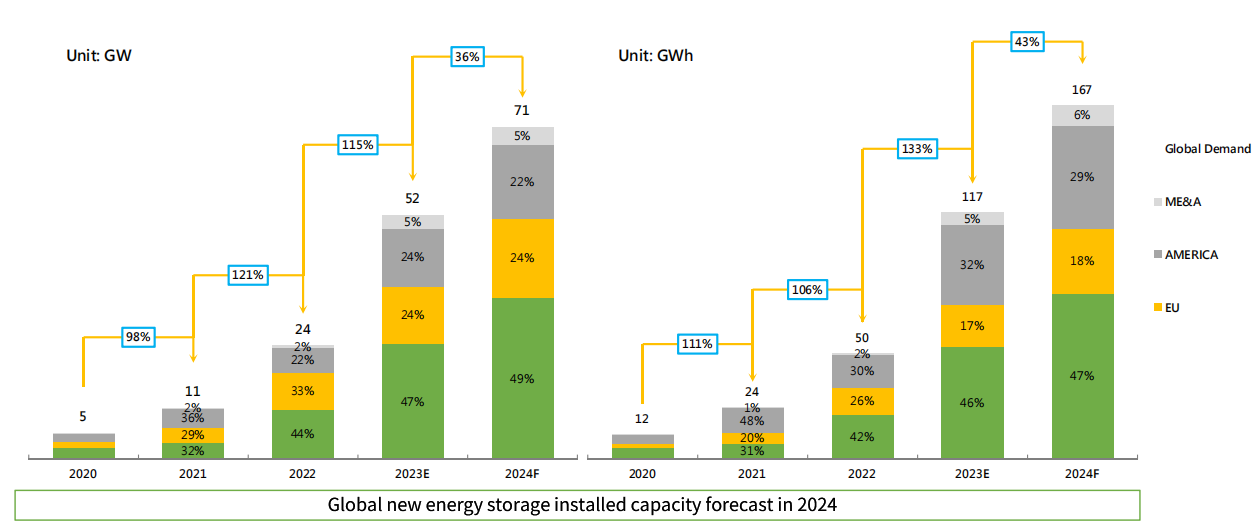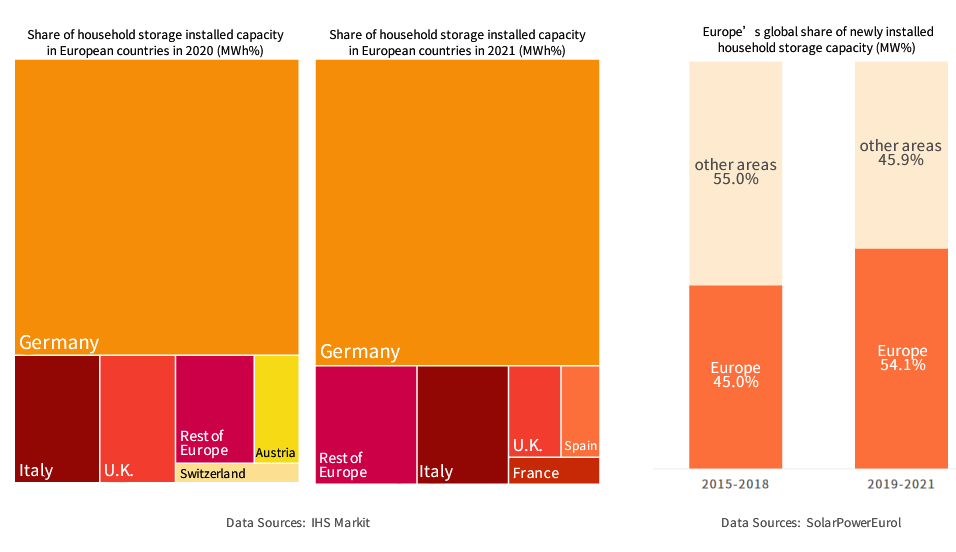
European household reserves: growth slows, led by Germany
2023-12-26 10:14European household reserves: growth slows, led by Germany
In recent years, the European market has been affected by rising energy prices, the price of residential electricity has soared, and the economy of energy storage is reflected. Driven by a sense of anxiety about the energy crisis, European regions have introduced policies to develop clean energy, accelerate the pace of energy transition to secure energy supply, household energy storage demand continues to grow.
Nowadays, with the impact of factors such as falling electricity prices, rising interest rates, and policy changes, the golden age of household storage seems to have shrunk. Although household storage still has a certain penetration rate to enhance the opportunity, but its growth rate has quietly slowed down.
01 Expected global household storage development in 2024
Looking ahead to 2024, in terms of the growth rate of global household storage, TrendForce Energy Storage Research Centre, a subsidiary of Tibco Consulting, expects that in 2024, the breakdown category of global new energy storage installations will show - industrial and commercial storage (93%/112%) > large storage (39%/43%) > household storage (4%/11%). The trend of household storage (4%/11%). Among them, household storage in the electricity prices and natural gas prices both fall in the background, the residents for the urgency of the installed capacity has weakened, in the growth rate of performance than in 2023 slowed down significantly, year-on-year growth of only 11%.
From the incremental point of view, in 2024 the global new energy storage installed capacity increment will be presented - large storage (53GW/130GWh) > household storage (10GW/20GWh) > industrial and commercial storage (7GW/18GWh) trend. Because the household storage volume start earlier, and profit model is more mature, still has some growth space, so the household storage in 24 years on the increment will still be slightly higher than the industrial and commercial storage.

02 European household reserves: growth slows, led by Germany
Due to the high degree of grid connectivity in Europe, the demand for large storage is not as strong as in other regions, thus unlike other markets where large storage accounts for absolute dominance, the European market presents a unique situation where the ratio of pre- and post-table storage is close to 1:1, making it the world's first household storage market. As Europe actively promote the energy transition, the European household storage installed capacity was once high. According to IHS Markit data, Germany and Italy's household storage installed growth rate is higher than the European average, the share of the first and second place; Germany accounted for more than 70%, is the largest country in the global household storage market.
European household storage market is currently highly concentrated, the top five countries accounted for about 90 per cent of the share, but with the gradual popularity of household storage in other European countries, the pace of growth of the first countries to appear different, France, Spain more than Austria and Tuanz, among the top five European household storage share.
Europe as a result of energy is mainly dependent on external supply, and residential electricity tariffs are much higher than the global average, but also higher than other regions of the developed world, such as Italy is one of the highest electricity prices in the world. European electricity spot price is closely related to natural gas, and driven by the energy crisis, 2022 electricity prices rose to an all-time high, residential electricity prices peaked at more than 0.7 euros / kWh, about 10 times China's civilian electricity prices. 2023 natural gas prices, although the Ming is down, but the demand for electricity he restored to the pre-epidemic level, the main European countries, residential electricity prices are still much higher than in 2020.
In addition, Europe's various taxes, surcharges and other components also lead to high costs, such as grid transmission and distribution costs, renewable energy surcharges, value-added tax, electricity tax, etc., the United Kingdom, Germany, Italy and other countries taxes accounted for the price of electricity 30% ~ 60%%. Affected by the price of natural gas, the grid and taxes and fees there is a certain degree of rigidity, the European household user electricity prices are higher than the cost of electricity for household photovoltaic storage.
Policy, due to the European countries are in different stages of the development of optical storage, the focus of the policy is also different. Germany, for example, Germany as the main European energy storage construction countries, pre-emptive, combinations of punches to support household storage. Germany's support for household storage originated earlier, using a combination of financing, taxation, subsidies and other policies.

The following are some of the recent related policy developments in Germany, Italy and the UK.
German Federal House of Representatives "Annual Tax Bill"
▲When: entry into force in 2023;
▲ Content:
① Income tax exemption (14-45%) for household PV systems <30kW;
② Income tax exemption for PV systems <15kW for multi-family attached mixed-use properties;
③Photovoltaic system & energy storage system procurement, exempt from value-added tax (VAT, 19%), actually simplifies the VAT exemption process;
▲Comment: Income tax exemption to stimulate the household market.
KFW Bank's Solar Power for Electric Cars Subsidy
▲When: published in September 2023
▲Content: financial subsidies for household light storage and charging systems, totalling £500 million;
▲Comments: the subsidy can account for 25% of the total cost; a single household subsidy of up to £10,200, a minimum of 50,000 systems can be subsidised, the number of household storage systems installed in Germany in 23 years is about 400,000-500,000, and the volume of subsidies is limited.
Italian Government Ecobonus Subsidy
▲When: released in 2020, rolled back in 2023
▲Content: home energy storage equipment tax breaks from the original 50-65% to 110% (extended to 2024), paid in 5 instalments over a 5-year period; later changed to 2023, 2024, 2025 gradually backsliding to 90%, 70%, 65%.
▲Comment: Subsidies are weakening and margins are down.
New UK Energy Storage Battery Tax Exemption
▲When: introduced in December 2023 and implemented on 1 February 2024
▲What: 20% VAT on the installation of Battery Energy Storage Systems (BESS) will be abolished from 1 February 2024, previously limited to batteries installed at the same time as solar panels;
▲Comment: energy storage systems are starting to be exempted from tax separately, favouring household solar storage.
